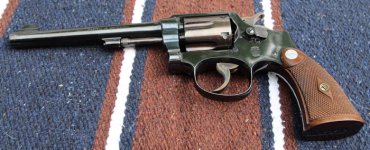What would cause the blued finish on a 1950 38/44 transitional
cylinder to turn a "plumb" color? This HE is chambered in .45 Colt with a blue 4 inch barrel and a pinned half moon front
sight. Looks like the barrel was cut back from a 5" or 6" bbl.
and re-blued and re-case hardened. Sort of a "Franken gun".
Any thoughts??
cylinder to turn a "plumb" color? This HE is chambered in .45 Colt with a blue 4 inch barrel and a pinned half moon front
sight. Looks like the barrel was cut back from a 5" or 6" bbl.
and re-blued and re-case hardened. Sort of a "Franken gun".
Any thoughts??
Last edited:

